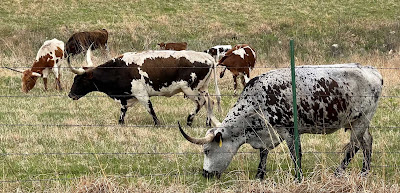.jpg) |
| 'Emily Carr' |
Please allow me, in the midst of the late May flush of roses, to begin in the next blog entry or three to introduce you to a few "new" friends. New, at least, to me, nearly new to my garden, survivors of at least one winter without protection and survivors of my general lack of proper garden attention.
This week, I bring you 'Emily Carr', a refined Canadian lady that I was introduced to in 2019. She was, at that time, only 12 years past her debutante ball, for 'Emily Carr' was debuted to the world in 2007 (another less-reliable source says 2005) as one of the later introductions of AgCanada. Bred by Lynn Callicott in 1982, she is a member of the AgCanada 'Canadian Artist Series', the only member of that series that I believe I grow. Her namesake (12/13/1871 -3/2/1945) was a Canadian Post-Impressionist artist and writer of British Columbia who was inspired by the Northwest Indigenous peoples and the British Columbia landscape.
'Emily Carr', as you can easily see, is a semi-double, bright red bloomer of medium stature and glossy, healthy foliage. At maturity, she is supposed to become 4 foot tall, although my 3 year old specimen is only 3 feet at present and a pair of posts on Houzz suggest that she goes over 5 1/2 feet in some instances. She struggled her first two years in my garden, an uncertain survivor of the triple plagues of cold, drought, and deer, but this year she popped up strong and solid, a striking arterial-blood-red scream against the pale pink tones of 'Blush Alba' behind her. According to helpmefindroses, she is a direct descendant of 'Morden Cardinette' and 'Cuthbert Grant'. I tried and lost the former, but 'Cuthbert' is a solid, healthy rose for me, slowly ending his own first bloom flush in his 22nd year. Father to daughter, those deep red genes held strong.'Emily Carr' is supposed to repeat reliably in flushes, but as she didn't have much of a bloom over her struggling years, I'll have to see what she can do for me this year. At least she seems to be rose rosette immune, having survived the onslaught of virus in my garden even during her struggles. I sadly can't detect much in the way of fragrance from her, a disappointment since I've always thought 'Cuthbert Grant' had a decent fragrance here in my garden and he, himself, was a descendant of fragrance legend 'Crimson Glory.' It's a pity that fragrance can be lost in so few generations if breeders don't pay attention.
One never knows where research on a given subject will lead in these days of Internet bounty. In this case, my searches for 'Emily Carr' led me down a rabbit hole to the Vineland Research and Innovation Centre and it's "49th Parallel Collection of Roses." And now I'm left wondering what 'Chinook Sunrise' would look like and how it would perform in Kansas. A little late to obtain this year, but maybe next year I can find her.

.jpg)
.jpg)
.jpg)

.jpg)

.JPG)
.JPG)
.JPG)
.JPG)
.JPG)
.JPG)
.JPG)
.JPG)


.jpg)
.jpg)
.jpg)
.jpg)